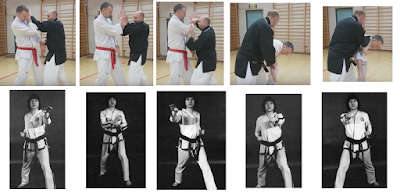 |
| Palm Hooking Block |
In this post I'll discuss four sets from the pattern and my preferred applications.
Irimi nage (moves 28-29/30-31)
 |
| Irimi nage vs a jab-cross. Source: AikiBushi |
For the jab-cross version, the front hand deflects an opponent's jab outwards, and then the rising block (back hand) comes up and deflects their cross inwards. The effect of this is to turn your opponent's body slightly sideways, which allows you to place your front hand on the small of their back (supporting hand) as you move forward and hook their head with the spearhand "strike". This throw is known as irimi nage ("entering throw") in Aikido. It helps if you come from a club that performs the spearhand at a downward angle, as my club does, but apparently this isn't the official version.
The other use of the cross-arm chamber is as a parry-pass against a single attack. This is shown in the image below. The ultimate effect should be the same: turn the opponent slightly and get access to their back.
 |
| Sources: Rogue Warriors and Southern Minnesota Martial Arts |
 |
| An intercepting block. Source: Fitness, Workout, & Exercise Videos |
One interpretation (from Sanko Lewis) is that it's an intercepting block in disguise, based on the logic that sets should begin with defensive techniques. The off-center location of the movement makes this feasible. Follow up with the two punches as strikes.
A second interpretation I like is that it represents your arm being grabbed and pulled. After having your arm pulled, you quickly pull back and strike the inside of the opponent's elbow (first middle punch). This lowers their head, allowing you to punch their jaw (second middle punch). The exact motions you use can be altered for practicality: you might hammerfist down on their inner elbow and uppercut their jaw, for example.
Elbow Roll Throw (Ending Set)
 |
| Turning into double forearm block as a throw. Source: Dan Djurdjevic |
Speaking of striking the elbow, one application for pivoting 270-degrees into double front block is a throw via rolling into the opponent's inner elbow. You can see Dan Djurdjevic show this in the right gif. In some arts this throw is called sumi otoshi (corner drop), although this is different than the Judo throw of the same name.
The front arm pulls the opponent's arm. The back arm rolls down into the opponent's elbow as you pull. We can use the previous move (rear foot X-stance backfist) as a strike. As you grab their arm (reaction hand), use the leap forward to ram into your opponent as you hit them with your forearm -- a backfist can be used if you have great accuracy, but as a ramming move, your forearm has a much higher likelihood of connecting. After you strike your opponent, quickly step out and rotate, performing the throw.
An alternative is to perform this as a proper shoulder throw (look it up!)
Palm Hooking Blocks
Finally we get to the palm hooking blocks. As stated above, the block is supposedly derived from taekkyeon. The motions are also reminiscent of "cloud hands" found in taijiquan (in fact, most taekkyeon hand motions may be based in taijiquan or a similar art). If you perform multiple palm hooking blocks continuously (rather than finishing one before starting the other), they do look like outward cloud hands, so a simple application for this set would be just deflecting a jab-cross outward before striking.
One application is use the first hooking block as a strike. The movement has a cross-arm chamber (although it usually isn't emphasized) similar to karate's shuto uke chamber, and Stuart Anslow in Ch'ang Hon Taekwon-do Hae Sul notes that the cupping shape of the palm makes it an ideal tool for striking the head. So we can use the reaction hand to parry an attack (chamber), before striking the opponent's head.
 |
| Source: Practical Kata Bunkai |
What if your opponent blocks you? Use the second hooking block to grab and drag the opponent's hand, pulling it as you punch them. In the pattern's official instructions, the second hooking block and the punch are meant to be performed as one motion. This application is very similar to Iain Abernethy's knifehand block drill shown in the right gif. (Fun fact: in the 1965 version of Yul-Gok, the movement is a "knifehand hooking block".)
The form follows with a second lunge punch the second time you perform this set. You could grab the back of the opponent's shirt, then step behind them for a throw (reaction hand pulls, punching hand pushes). Another interpretation is to use the first "punch" to press onto the opponent's elbow after you grab their arm, putting them into an armbar. You then move forward into the second lunge punch to strike their head.
 |
| Application for Yul-Gok 18-21. Source for top row: Orjan Nilsen |
Footnotes
1) A couple other "blocks" that might not have a Shotokan basis are the nine-block and double arc hand block in Gae-Baek. I don't know all 26 Shotokan kata so I could be wrong, but these two blocks are usually associated with taekwondo. The nine-block is used in jujitsu as an arm break. The double arc hand is reminiscent of the body pushing in taijiquan.
2) Aiki-jujitsu was being taught in Korea at the time Yul-Gok was developed (it's what Hapkido is based on), and we know that early taekwondoin studied jujitsu, as locks appear in both The Encyclopedia of Taekwon-Do and General Choi's 1965 book Tae Kwon Do: The Art of Self-Defense. There is more evidence of an aiki-jujitsu influence in the 1st Dan pattern Gae-Baek.
Sources
http://sooshimkwan.blogspot.com/2010/10/hooking-block.html
https://www.youtube.com/watch?v=pvTl79CUzA4
https://www.youtube.com/watch?v=FQHLSV3sIgw
https://www.youtube.com/watch?v=IS7tizMm8Fg
https://www.youtube.com/watch?v=pL1D72Fueu4
http://sooshimkwan.blogspot.com/2012/04/poetry-in-motion-poetic-interpretation.html
https://www.youtube.com/watch?v=V0rD4LXKo4w
https://www.youtube.com/watch?v=iY9kv_fclrE
https://www.youtube.com/watch?v=6s-cUKdDeuU
https://www.youtube.com/watch?v=h4MeTwPPKfQ
http://jungdokwan-taekwondo.blogspot.com/2017/04/basic-taekwondo-limb-control-drill.html